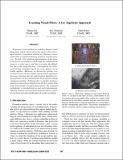| dc.contributor.author | Lin, Dahua | |
| dc.contributor.author | Grimson, Eric | |
| dc.contributor.author | Fisher, John W., III | |
| dc.date.accessioned | 2010-10-14T19:11:25Z | |
| dc.date.available | 2010-10-14T19:11:25Z | |
| dc.date.issued | 2009-08 | |
| dc.identifier.isbn | 978-1-4244-3992-8 | |
| dc.identifier.issn | 1063-6919 | |
| dc.identifier.other | INSPEC Accession Number: 10835859 | |
| dc.identifier.uri | http://hdl.handle.net/1721.1/59336 | |
| dc.description.abstract | We present a novel method for modeling dynamic visual phenomena, which consists of two key aspects. First, the integral motion of constituent elements in a dynamic scene is captured by a common underlying geometric transform process. Second, a Lie algebraic representation of the transform process is introduced, which maps the transformation group to a vector space, and thus overcomes the difficulties due to the group structure. Consequently, the statistical learning techniques based on vector spaces can be readily applied. Moreover, we discuss the intrinsic connections between the Lie algebra and the Linear dynamical processes, showing that our model induces spatially varying fields that can be estimated from local motions without continuous tracking. Following this, we further develop a statistical framework to robustly learn the flow models from noisy and partially corrupted observations. The proposed methodology is demonstrated on real world phenomenon, inferring common motion patterns from surveillance videos of crowded scenes and satellite data of weather evolution. | en_US |
| dc.description.sponsorship | Heterogeneous Sensor Networks | en_US |
| dc.language.iso | en_US | |
| dc.publisher | Institute of Electrical and Electronics Engineers | en_US |
| dc.relation.isversionof | http://dx.doi.org/10.1109/CVPRW.2009.5206660 | en_US |
| dc.rights | Article is made available in accordance with the publisher's policy and may be subject to US copyright law. Please refer to the publisher's site for terms of use. | en_US |
| dc.source | IEEE | en_US |
| dc.title | Learning Visual Flows: A Lie Algebraic Approach | en_US |
| dc.type | Article | en_US |
| dc.identifier.citation | Dahua Lin, E. Grimson, and J. Fisher. “Learning visual flows: A Lie algebraic approach.” Computer Vision and Pattern Recognition, 2009. CVPR 2009. IEEE Conference on. 2009. 747-754. © 2009 IEEE | en_US |
| dc.contributor.department | Massachusetts Institute of Technology. Computer Science and Artificial Intelligence Laboratory | en_US |
| dc.contributor.department | Massachusetts Institute of Technology. Department of Electrical Engineering and Computer Science | en_US |
| dc.contributor.approver | Fisher III, John W. | |
| dc.contributor.mitauthor | Lin, Dahua | |
| dc.contributor.mitauthor | Grimson, Eric | |
| dc.contributor.mitauthor | Fisher, John W., III | |
| dc.relation.journal | IEEE Conference on Computer Vision and Pattern Recognition, 2009. CVPR 2009. | en_US |
| dc.eprint.version | Final published version | en_US |
| dc.type.uri | http://purl.org/eprint/type/JournalArticle | en_US |
| eprint.status | http://purl.org/eprint/status/PeerReviewed | en_US |
| dspace.orderedauthors | Dahua Lin; Grimson, E.; Fisher, J. | en |
| dc.identifier.orcid | https://orcid.org/0000-0003-4844-3495 | |
| dc.identifier.orcid | https://orcid.org/0000-0002-6192-2207 | |
| dspace.mitauthor.error | true | |
| mit.license | PUBLISHER_POLICY | en_US |
| mit.metadata.status | Complete | |
